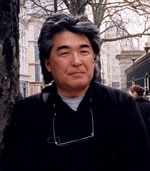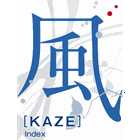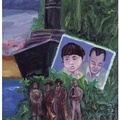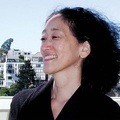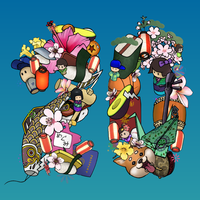What does "Hiroshima" mean to Steven Okazaki (1952-), a third-generation Japanese-American? Two years ago, in 2007, he produced the documentary "Hiroshima Nagasaki" (originally titled White Light/Black Rain), which interviewed Hiroshima atomic bomb survivors and American soldiers involved in the atomic bombing. It was broadcast on American cable television on August 6th of that year, and was also screened in Japan. It won an Emmy Award last fall.
I want to portray the current state of Hiroshima, which is fading from memory.
Okazaki's interest in Hiroshima began when he read the English version of Nakazawa Keiichi's Barefoot Gen in his late twenties. He later participated in a group for American atomic bomb survivors in San Francisco, which led him to make a documentary on the subject. American atomic bomb survivors are Japanese and Japanese-Americans who traveled to the mainland US after the Hiroshima bombing. This was his documentary film, Survivors, which was released in 1982. While it is somewhat known that Koreans and Chinese were victims of the atomic bomb, it seems that even today not much is known about the experiences of Japanese-Americans. This, too, makes one feel the gap between Japanese and Japanese-Americans.
It was exactly a quarter century between "Survivors" and "Hiroshima, Nagasaki." In that time, Okazaki interviewed as many as 500 atomic bomb survivors. In the 1990s, there was a plan for a joint production between NHK and the American PBS to film "Hiroshima Now," but after many twists and turns, the plan fell through. Nevertheless, Okazaki remained fixated on the atomic bomb. At that time, he answered the following in an interview with the Chugoku Shimbun:
"I would like to take up issues such as Korean A-bomb survivors living in Japan, people with microcephaly caused by the atomic bomb, and the second generation of atomic bomb survivors. I would also like to frankly portray what Hiroshima should convey now that the Cold War has ended, and how Hiroshima is fading in the shadow of Japan's economic development." (Chugoku Shimbun, morning edition, April 8, 1994)
Okazaki's interest in Hiroshima had already expanded greatly by this time. Although he had not yet made a work on Korean atomic bomb survivors, Korean atomic bomb survivor Kim Ban-young appeared as one of the witnesses in "Hiroshima Nagasaki." In 2005, he also made a 35-minute short documentary called "Mushroom Club" about people with microcephaly caused by the atomic bomb, which was nominated for an Academy Award in the Best Documentary Short category the following year in 2006. What is wonderful about Okazaki is that he takes his time to put into practice each and every one of his words.
The voices of atomic bomb survivors that could only be drawn out by Japanese Americans
It is believed that there are approximately 1,000 atomic bomb survivors living in the United States.
In 1941 during World War II, there were approximately 30,000 second-generation Japanese in Japan, of which 4,800 were in Hiroshima. This shows how many immigrants came from Hiroshima. The number of Japanese in Nagasaki is unknown.
There were many reasons why Japanese Americans stayed in Japan: some were born in the United States but stayed in Japan for an education (Kibei Nisei), others stayed in Japan looking for a spouse, others married Japanese people and stayed in Japan, others came to Japan with their first generation parents to visit relatives, and still others who felt that anti-Japanese sentiment was growing in the United States and so returned to Japan.
In addition to these Japanese-Americans who were exposed to the atomic bomb in Japan, there were Japanese who were exposed to the atomic bomb in Hiroshima and Nagasaki, and after the war, there were those who had no relatives and went to America or Canada in search of a new place, and those who moved to South America as a result of the government's immigration policies.
The exact number is unknown, as some people do not disclose that they are A-bomb survivors. If one discloses their status, they run the risk of losing their job or having their health insurance suspended, and in the first place, it is difficult to speak out as a A-bomb survivor in a climate that justifies the dropping of the atomic bomb. There are 190 confirmed cases in South America and 20 in Canada.
"Survivors" features over a dozen A-bomb survivors living in the United States, but the most striking testimony is that of Shigeko Sasamori, who has deep keloid scars on her face and hands. She was 13 years old when the bomb was dropped. After the war, as one of the so-called "atomic bomb girls," she underwent as many as 25 plastic surgeries over a period of a year and a half in the United States. She continued to visit hospitals for 10 years after returning to Japan.
Sasamori also appeared in "Hiroshima Nagasaki" as a witness, and I felt like I was meeting someone I'd grown up with again.
"I often think about what my life would have been like if I had not been exposed to the atomic bomb. It would have been completely different. I would probably have gotten married and become a wife and a mother. I find myself thinking about all sorts of things."
Sasamori's words struck me deeply.
*This article is a reprint of the second installment of the column series "From the Perspectives of Two Countries" in Renso Publishing 's online magazine "Kaze," which features information about new books, such as articles linking new books to current issues and daily topics, as well as monthly bestsellers and review columns of new books.
© 2009 Association Press and Tatsuya Sudo


